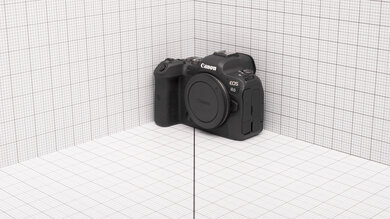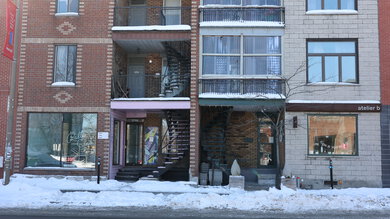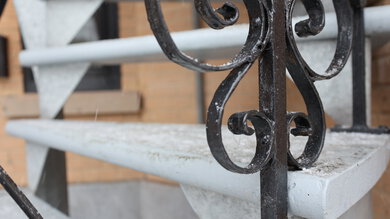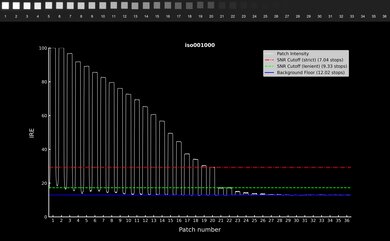The Canon EOS R6 is a full-frame hybrid camera, first released in 2020. As a more affordable alternative to the pro-grade Canon EOS R5, it has a lot to offer for enthusiast photographers and video shooters, with well-rounded features for both mediums, including in-body image stabilization, quick burst shooting, and internal 10-bit video recording. Though its sensor doesn't have the highest resolution among its peers, it's still an incredibly capable camera that can take high-quality photos and videos. That said, it's somewhat held back in the video department by a tendency to overheat during longer recording sessions and a 30-minute recording time limit.
Our Verdict
If you don't mind a bulkier kit, the Canon R6 camera is good for travel photography. While it's more portable than a traditional DSLR, it's still a fairly heavy and large full-frame camera, and full-frame lenses can quickly add bulk. That said, the camera captures very high-quality images and has an impressive autofocus system that does an excellent job of keeping fast subjects in focus, even in busier scenes. The camera also has a great battery life for a mirrorless model.
- Fantastic overall image quality.
- Impressive autofocus performance.
- Weather-sealed.
- Not very portable.
The Canon R6 is impressive for landscape photography. It has remarkable dynamic range to capture a wider array of highlight and shadow detail, which is ideal for landscape photos. It also performs amazingly well in low light, with excellent noise management when shooting in dimly lit conditions. On top of that, the camera is well-built, with weather-sealing for more peace of mind outdoors, and comfortable to handle. That said, it isn't the most portable camera, and it has a lower-resolution sensor than many of its peers, meaning you'll have a bit less leeway to crop in your photos.
- Remarkably wide dynamic range.
- Great noise handling in low light.
- Weather-sealed.
- Not very portable.
- Sensor doesn't have the highest resolution compared to competitors.
The Canon R6 is great for sport and wildlife photography. Its image quality is fantastic, and it has an excellent autofocus system with a very reliable tracking feature for moving human subjects. It also includes subject detection modes for birds and animals. Its mechanical burst rate is very quick, too, and it has an even faster burst rate with its electronic shutter, though you're more likely to see rolling shutter artifacts in e-shutter mode since it has a fairly slow sensor readout. Thankfully, it has a very large photo buffer, so it's unlikely to slow you down when shooting extended bursts.
- Fantastic overall image quality.
- Impressive autofocus performance.
- Relatively quick burst rate.
- Not very portable.
- Long buffer empty time.
The Canon R6 is okay for vlogging, though this isn't its intended use. It's best suited to sit-down or studio vlogging, with excellent video quality, in-body image stabilization, and 4k recording at up to 60 fps. It also has a fully articulated screen that makes it easy to monitor yourself. However, it's too bulky and heavy for on-the-go or walk-and-talk vlogs.
- Impressive video quality.
- Fully articulated screen.
- In-body image stabilization.
- Not very portable.
- Noticeable rolling shutter effect in 4k.
- Can overheat during longer recording sessions in 4k.
The Canon R6 is a good option for studio video. It records oversampled 4k video at up to 60 fps, with internal 10-bit 4:2:2 recording in C-Log and HDR PQ formats, which is great if you need to preserve a wider range of detail and want more flexibility to color-grade your footage. It includes inputs for accessories like headphones and a microphone. Unfortunately, it has a 30-minute recording time limit and can overheat with longer recording sessions in 4k. There's also a slight crop when shooting in 4k, though it still captures excellent overall video quality with a fairly wide dynamic range.
- Impressive video quality.
- Internal 10-bit Log recording.
- 4k at up to 60 fps.
- Slight crop when shooting in 4k.
- Can overheat during longer recording sessions in 4k.
The Canon R6 isn't designed for action video, though it's suitable for recording action from the sidelines. It isn't meant for action cam mounts and isn't the most portable camera. While it's weather-sealed, it isn't waterproof, something to keep in mind if you're in extreme conditions. It can also overheat with longer recording sessions in 4k. High frame rate options are also somewhat limited, though it can capture 1080p footage at 120 fps in its slow-motion recording mode. On the upside, it captures very high-quality footage, and its in-body image stabilization feature helps smooth out camera shake when recording handheld.
- Impressive video quality.
- Weather-sealed.
- In-body image stabilization.
- Not waterproof or designed for action video rigs.
- Not very portable.
- Limited frame rate options for action video.
- Noticeable rolling shutter effect in 4k.
The Canon R6 captures impressive RAW image quality. It has fantastic dynamic range, so it captures a wide array of detail and is well-suited to high-contrast scenes. Its noise handling is also great, with very clean files even with little available light. While its sensor has a slightly lower resolution than some of its full-frame peers, images still have a good amount of fine detail; you just won't have quite as much leeway to crop in.
- Remarkably wide dynamic range.
- Great noise handling in low light.
- Sensor doesn't have the highest resolution compared to competitors.
Performance Usages
Changelog
-
Updated Dec 12, 2024:
We wrote text for the new tests added in Test Bench 0.13 and updated the Verdict section accordingly.
- Updated Dec 12, 2024: We've converted this review to Test Bench 0.13. We've added new tests for Video Dynamic Range and Luminosity Patch Detection. You can learn more about these updates in the changelog.
- Updated Jan 29, 2024: Added text to the 'Raw Photo Performance' verdict box.
- Updated Jan 29, 2024: Converted to Test Bench 0.12.1.
Check Price
Differences Between Sizes And Variants
The Canon EOS R6 is available in 'Black'. You can see the label for the model we tested here.
We purchased the camera with the RF 24-105mm f/4-7.1 IS STM lens, but you can also buy it bundled with an RF 24-105mm f/4 L IS USM lens or without a lens at all.
If you come across a different version of this camera, let us know so we can update our review.
Popular Camera Comparisons
The Canon EOS R6 is an enthusiast-level hybrid camera. Though it uses a lower-resolution sensor than many of its peers, it still holds its own for photography, with excellent noise handling and plenty of dynamic range. That said, while it's an excellent video camera for its class, it does have a couple of limitations that have improved on the Canon EOS R6 Mark II—namely, some overheating issues when recording for longer durations in 4k and a 30-minute recording time limit.
For other options, check out the best cameras, the best full-frame mirrorless cameras, or the best cameras for photography.
The Canon EOS R6 Mark II is the mid-cycle refresh of the Canon EOS R6. While the Mark II does offer some notable improvements and quality-of-life upgrades, they're very similarly performing cameras overall. Some of the updates include a higher-resolution sensor with a faster readout speed, an updated autofocus system, and video quality-of-life upgrades like no recording time limits, no 4k crop, and better heat management. While these aren't game-changing updates, they are an improvement that might cinch the deal for you if you're trying to decide between these two cameras. That said, the original EOS R6 is still a fantastic camera, and the Mark II likely isn't worth the upgrade if you already own the older model.
The Canon EOS R6 is a bit better than the Canon EOS R8. It's a higher-end model with better build quality and a much longer battery life. Though it has a slightly lower resolution sensor, image quality is roughly on par. It also has in-body image stabilization. That said, the R8 is more portable and uses a newer version of Canon's autofocus system.
The Canon EOS R7 and the Canon EOS R6 perform similarly overall, using different-sized sensors. The R7 has an APS-C sensor, so it's a tad more portable. It also has a slightly longer battery life and a faster max burst rate. The R6, meanwhile, delivers better overall image quality and is better suited to low-light situations because of its full-frame sensor.
The Canon EOS R6 is better overall than the Sony α7 III. Both feature excellent full-frame sensors capable of capturing high-quality images. However, the Canon has a better IBIS system, a more effective autofocus system, and better internal video recording capability.
Test Results

The Canon R6 isn't especially portable, although it's still more compact than a typical full-frame DSLR. It's a fairly heavy body, but it'll feel well-balanced with full-frame lenses.
The Canon R6's build quality is great. The body is made of magnesium alloy, with a hard plastic exterior that feels quite solid overall. The screen rotation mechanism feels sturdy, and the buttons and dials offer good physical feedback. The camera's weather-sealed, giving you a bit more peace of mind when shooting outdoors. The battery compartment on the bottom and the SD card compartment on the side of the camera are covered with locking hinged doors, while the other inputs have sealed rubber flaps.
The Canon R6 has fantastic ergonomics. The handgrip is large and well-suited for most hand sizes, with a grippy texture that makes it easy to hold. With three command dials, it's super easy to adjust exposure settings without using additional buttons or diving into the menus. The buttons are also well-placed.
The viewfinder has a fairly high resolution. You'll still get a sharp image through the viewfinder, but not as crisp as higher-res EVFs, like the one found on the Canon EOS R6 Mark II. The rubber eyecup is also soft and comfortable.
Like most Canons, the R6 has a fully articulated screen that's good for video work or shooting at unusual angles. It has a high resolution, ensuring you get a sharp image when shooting with the screen, and you can use the touchscreen to navigate the menu, select focus points, or as a touch shutter.
As is typical for Canon, the menu system is fantastic and intuitively organized. While the options are extensive, they're not overwhelming. There are also many customization options to tailor the settings to your liking. Pressing the 'Info' button when available brings up the 'Help' function, which explains some of the more complicated features and settings.
For users who want to easily transfer photos to their phone, the Canon Camera Connect app connects the camera to your phone via Bluetooth or Wi-Fi. You can transfer files or control the camera remotely with a Wi-Fi connection. Unlike many other camera apps, you can still use and adjust the settings on the camera itself while using the app for Live View/remote control. That said, the Live View function and even shutter release through the app have a significant lag.
The Canon R6 has a good battery life. It uses the same LP-E6NH battery as the Canon EOS R6 Mark II, which has an excellent CIPA rating of about 580 shots in live view or 320 shots through the viewfinder. You can expect roughly similar performance here, though actual battery performance can vary drastically with real-world usage.
Regarding video, the battery life is decent. We managed just over an hour and a half of continuous video recording in 4k at 30 fps, which is a fairly long time but isn't game-changing. If you want to extend the camera's battery life, it does support external power supply via USB-C. Canon sells its own USB power adapter for this purpose, which you can see here. However, other adapters or power banks can also work to power the camera as long as they support power delivery and have a sufficiently high wattage. For instance, we could power the camera via USB-C with a 65W charger but not a 10W charger.
The Canon R6 can shoot at a quick max burst rate, which is great for sports and other fast action. When using the electronic shutter, the max burst rate is even quicker. However, rolling shutter artifacts are more likely with the e-shutter, especially with very fast-moving subjects or if you're tracking a subject horizontally. When shooting in JPEG with a high-speed SD card, the photo buffer is virtually limitless, so you can shoot bursts indefinitely. Even when shooting RAW files, you can shoot around 250 frames before it slows down, which is substantial. That said, if you manage to fill up the buffer, it takes quite a while to empty.
The Canon R6 uses Canon's Dual Pixel CMOS AF II autofocus system. Thanks to deep-learning AI technology, it supports human face or eye detection and can track people even with masks or sunglasses or when they turn around or leave the frame. It also includes subject detection for animals like cats, dogs, and birds. The user interface for AF is very intuitive, and you get plenty of area modes and configuration options to choose from, making it easy to tailor the AF exactly to your needs. Canon also advertises that it can focus in lighting conditions as dark as -6.5EV.
In our tracking test, the camera does an amazing job of keeping moving human subjects in focus, even through quicker or more erratic movements. It isn't perfect, but you'll get an incredibly high rate of keepers in most situations.
If you don't want to rely on AF tracking and prefer to use the center point to track a moving subject, the camera is very reliable. Using the Canon RF 24-105mm f/4-7.1 IS STM lens, the camera can quickly and accurately gauge a subject's distance and maintain focus as they move. You're unlikely to miss focus in scenarios where a subject is moving more predictably.
The Canon R6 includes a five-axis in-body sensor-shift stabilization system, which Canon says offers up to 8 stops of stabilization depending on which lens you pair it with. We tested stabilization with the RF 24-105mm f/4-7.1, which includes optical stabilization that works in tandem with the camera's IBIS. Overall, it does an impressive job of steadying handheld shots, allowing you to get clear images at very slow shutter speeds. That said, stabilization can vary depending on many factors, including not just the lens and focal length but also how steady your hands are.
The Canon R6's dynamic range is superb. Its sensor can capture a very wide range of highlight and shadow detail, which is great for high-contrast scenes like landscapes.
The Canon R6 has a good amount of resolving power, but it can't capture as much fine detail as some of its peers, with higher-resolution sensors, like the Sony α7 IV. You can still capture very sharp images, but there's simply less detail when you punch in, giving you a bit less leeway to crop your photos without losing resolution.
The Canon R6's RAW noise handling is great. It performs very well in low light, keeping noise relatively minimal.
The Canon R6 records UHD 4k video, oversampled from 5.1k, which is nearly the full resolution of its sensor. It can output 10-bit 4:2:2 video to a compatible external recorder via HDMI and supports C-Log internally to capture a wider dynamic and tonal range.
The Canon R6 can record 4k at up to 60 fps, and while there's a slight crop, it isn't very noticeable. It's still an improvement over competitors like the Sony α7 IV or the Panasonic LUMIX DC-S5, which can only record 4k / 60 fps video with a Super 35 crop.
The Canon R6 has good internal recording capability in 4k. The standard movie mode records in 8-bit, but the camera includes two different 10-bit 4:2:2 shooting modes: Canon Log (or C-Log) and HDR PQ. C-Log gives you a flatter image to preserve a wider range of detail and gives you more flexibility to color-grade your footage. The HDR PQ mode also preserves a wider range of detail but is geared specifically for HDR displays.
The camera has a 30-minute recording time, which is plenty of length for most uses, but can still be limiting. Many newer cameras have done away with that kind of time limit, including the Canon EOS R6 Mark II. The camera's biggest downside is heat management. It can overheat fairly quickly when recording for longer periods in 4k, though you'll be fine if you shoot shorter takes with breaks in between. Another thing worth noting: if you're using an SD/SDHC card, the camera can only record files up to 4GB, breaking up recordings into multiple files if they exceed that. With an SDXC card, you'll get one long video file, even if it exceeds 4GB.
The Canon R6 has an excellent autofocus system that works incredibly well in 4k. Its face-tracking feature does a remarkable job of keeping moving subjects in focus and staying with them even if they turn around. It can get slightly thrown off if the subject pops in and out of frame, but overall, it's a very quick and responsive tracking system.
Unfortunately, rolling shutter effect is very apparent in 4k. There's noticeable skewing and "wobble" whenever you pan the camera, especially with quicker camera movements.
The Canon R6 can record regular 1080p video at up to 60 fps, with a high frame rate mode that records 1080p at 120 fps with no audio and slow-motion playback. There's no crop in either mode, which is great.
The camera's FHD internal recording capability is great. There's still a 30-minute cap on recording, but the camera is less likely to overheat in 1080p. Once again, you can record 10-bit 4:2:2 video internally with C-Log or HDR PQ.
The Canon R6's AF is as good in 1080p as in 4k. It has little trouble keeping moving human subjects in focus and supports both face and more precise eye tracking. If you manually select a target for it to follow, it still does an impressive job. It's a very responsive and reliable AF system overall.
Thankfully, there's significantly less rolling shutter distortion in 1080p. You can still notice some skewing or wobbling with very quick camera pans, but it won't be overly distracting or noticeable in most cases.
The Canon EOS R6 has good video dynamic range. When recording 4k video in C-Log3, it captures a max of about 12 stops, but your usable dynamic range will be closer to about 9 stops, accounting for noise. While that's enough to capture a fairly wide range of detail in high-contrast scenes, it's significantly less than a lot of its full-frame peers, like the Panasonic LUMIX S5 or Sony α7 IV, so you won't have quite as much flexibility in trickier lighting conditions. At C-Log3's base ISO of 800, there's also little headroom for overexposure, so it'll be more crucial to get the exposure right in-camera since you won't have as much leeway to recover highlights in post.
Tested settings:
- Resolution: 4k
- Frame Rate: 30 fps
- Log Format: C-Log3
The camera does a decent job of preserving details across most of its ISO range, though you'll have the greatest dynamic range at ISO 800, which is the base ISO for C-Log3, or higher. The camera is especially good at preserving highlight detail at moderate ISO settings. Beyond ISO 6400, however, you'll have more clipping in the highlights without gaining much additional detail in the shadows.
Tested settings:
- Resolution: 4k
- Frame Rate: 30 fps
- Log Format: C-Log3
The Canon R6 uses a USB-C port for charging and file transfer. It includes both a headphone and microphone jack, which is great for monitoring audio in-camera. There's also a Micro HDMI port, which means you'll need an adapter to connect an external recorder, unlike a camera like the Sony α7 IV, which uses a full-sized HDMI port.






















